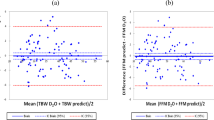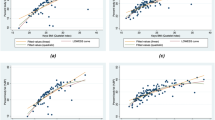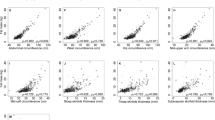Abstract
Objectives: To test and compare the validity of a body mass index (BMI)-based prediction equation and an impedance-based prediction equation for body fat percentage among various European population groups.
Design: Cross-sectional observational study.
Settings: The study was performed in five different European centres: Maastricht and Wageningen (The Netherlands), Milan and Rome (Italy) and Tampere (Finland), where body composition studies are routinely performed.
Subjects: A total of 234 females and 182 males, aged 18–70 y, BMI 17.0–41.9 kg/m2.
Methods: The reference method for body fat percentage (BF%REF) was either dual-energy X-ray absorptiometry (DXA) or densitometry (underwater weighing). Body fat percentage (BF%) was also predicted from BMI, age and sex (BF%BMI) or with a hand-held impedance analyser that uses in addition to arm impedance weight, height, age and sex as predictors (BF%IMP).
Results: The overall mean (±s.e.) bias (measured minus predicted) for BF%BMI was 0.2±0.3 (NS) and−0.7±0.3 (NS) in females and males, respectively. The bias of BF%IMP was 0.2±0.2 (NS) and 1.0±0.4 (P<0.01) for females and males, respectively. There were significant differences in biases among the centres. The biases were correlated with level of BF% and with age. After correction for differences in age and BF% between the centres the bias of BF%BMI was not significantly different from zero in each centre and was not different among the centres anymore. The bias of BF%IMP decreased after correction and was significant from zero and significant from the other centres only in males from Tampere. Generally, individual biases can be high, leading to a considerably misclassification of obesity. The individual misclassification was generally higher with the BMI-based prediction.
Conclusions: The prediction formulas give generally good estimates of BF% on a group level in the five population samples, except for the males from Tampere. More comparative studies should be conducted to get better insight in the generalisation of prediction methods and formulas. Individual results and classifications have to be interpreted with caution.
European Journal of Clinical Nutrition (2001) 55, 973–979
This is a preview of subscription content, access via your institution
Access options
Subscribe to this journal
Receive 12 print issues and online access
$259.00 per year
only $21.58 per issue
Buy this article
- Purchase on Springer Link
- Instant access to full article PDF
Prices may be subject to local taxes which are calculated during checkout
Similar content being viewed by others
References
Baumgartner RN, Chumlea WC & Roche AF (1989) Estimation of body composition from bioelectrical impedance of body segments Am. J. Clin. Nutr. 50 221–226
Bland JM & Altman DG (1986) Statistical methods for assessing agreement between two methods of clinical measurements Lancet i 307–310
Deurenberg P (1992) The assessment of body composition: uses and misuses. Annual Report Lausanne: Nestlé Foundation
Deurenberg P & Deurenberg-Yap M (2001) Validation of skinfold thickness and hand-held impedance measurements for estimation of body fat percentage among Singaporean Chinese, Malays and Indians Asia Pacific J. Clin. Nutr. (in press).
Deurenberg P, Weststrate JA & Seidell JC (1991) Body mass index as a measure of body fatness: age and sex specific prediction formulas Br. J. Nutr. 65 105–114
Deurenberg P, Westerterp KR & te Wierik E (1994) Between-laboratory comparison of densitometry and bio-electrical impedance measurements Br. J. Nutr. 71 309–316
Deurenberg P, Yap M & Van Staveren WA (1998) Body mass index and percent body fat: a meta analysis among different ethnic groups Int. J. Obes. Relat. Metab. Disord. 22 1164–1171
Deurenberg P, Deurenberg-Yap M, Wang J, Lin Fu Po & Schmidt G (1999) The impact of body build on the relationship between body mass index and body fat percent. Int. J. Obes. Relat. Metab. Disord. 23 537–542
Deurenberg-Yap M, Schmidt G, Staveren WA & Deurenberg P (2000) The paradox of low body mass index and high body fat percent among Chinese, Malays and Indians in Singapore Int. J. Obes. Relat. Metab. Disord. 24 1011–1017
Durnin JVGA & Womersley J (1974) Body fat assessed from total body density and its estimation from skinfold thickness: measurements on 481 men and women aged from 17 to 72 y Br. J. Nutr. 32 77–97
Eveleth PB & Tanner JM (1976) World-wide Variation in Human Growth. Cambridge: Cambridge University Press
Fogelholm M, Kukkonen-Harjula K, Sievänen H, Oja P & Vuori I (1996) Body composition assessment in lean and normal-weight young women Br. J. Nutr. 75 793–802
Fuller NJ & Elia M (1989) Potential use of bioelectrical impedance of the ‘whole body’ and of body segments for the assessment of body composition: comparison with densitometry and anthropometry Eur. J. Clin. Nutr. 43 779–791
Gallagher D, Visser M, Sepulveda D, Pierson RN, Harris T & Heymsfield SB (1996) How useful is BMI for comparison of body fatness across age, sex and ethnic groups Am. J. Epidemiol. 143 228–239
Going SB (1996) Densitometry In Human Body Composition, eds. AF Roche, SB Heymsfield & TG Lohman. Champaign, IL: Human Kinetics
Jansen DF, Korbijn CM & Deurenberg P (1992) Variability of body density and body impedance at different frequencies Eur. J. Clin. Nutr. 46 865–871
Jebb SA & Elia M (1993) Techniques for the measurement of body composition: a practical guide Int. J. Obes. Relat. Metab. Disord. 17 611–621
Jebb SA, Cole TJ, Doman D, Murgatroyd PR & Prentice AM (2000) Evaluation of the novel Tanita body-fat analyser to measure body composition by comparison with a four-compartment model Br. J. Nutr. 83 115–122
Lohman TG (1992) Advances in Body Composition Assessment Champaign, IL: Human Kinetics
Loy SF, Likes EA, Andrews PM, Vincent WJ, Holland HJ, Kawai H, Cen S, Swenberger J, van Loan M, Tanaka K, Heyward V, Stolarczyk L, Lohman TG & Going SB (1998) Easy grip on body composition measurements ACSM's Health Fitness J. 2 16–19
Lukaski HC (1987) Methods for the assessment of body composition: traditional and new Am. J. Clin. Nutr. 46 437–456
Lukaski HC, Johnson PE, Bolonchuck WW & Lykken GE (1985) Assessment of fat free mass using bioelectrical impedance measurements of the human body Am. J. Clin. Nutr. 41 810–817
Luke A, Durazo-Arvizzu R, Rotimi C, Prewitt E, Forrester T, Wilks R, Ogunbiyi OL, Schoeller DA, McGee D & Cooper RS (1997) Relation between BMI and body fat in black population samples from Nigeria, Jamaica and the United States Am. J. Epidemiol. 145 620–628
Motley HL (1957) Comparison of simple helium dilution with the oxygen open-circuit method for measuring residual air Am. Rev. Tuberc. Pulmon. Dis. 76 701–715
NIH (1994) Bioelectrical impedance analysis in body composition measurement. NIH Technology Assessment Statement, December 12–14 pp 1–35
Norgan NG (1995) The assessment of the body composition of populations In Body Composition Techniques in Health and Disease, eds PSW Davies, TJ Cole. Cambridge: Cambridge University Press
Nunez C, Gallagher D, Visser M, Pi-Sunyer FX, Wang ZM & Heymsfield SB (1997) Bioimpedance analysis: evaluation of leg-to-leg system based on pressure contact foot-pad electrodes Med. Sci. Sports Exerc. 29 524–531
Paton N, Macallan D, Jebb S, Pazianas M & Griffin G (1995) Dual energy X-rays absorptiometry results differ between machines Lancet 346, 899–900
Schrauwen P, van Marken Lichtenbelt WD, Saris WHM & Westerterp KR (1997) Changes in fat oxidation in response to a high-fat diet Am. J. Clin. Nutr. 66 276–282
Siri WE (1961) Body composition from fluid spaces and density: analysis of methods In Techniques for Measuring Body Composition, eds. J Brozek & A Henschels pp 223–244 Washington DC: National Academy of Sciences
Snijder MB, Kuyf BEM & Deurenberg P (1999) The effects of body build on the validity of predicted body fat from body mass index and bioelectrical impedance Ann. Nutr. Metab. 43 277–285
SPSS/Windows V10.0.0. Chicago (1999) IL: SPSS Publishing
Swinburn BA, Craig PL, Daniel R, Dent DPD & Strauss BJG (1996) Body composition differences between Polynesians and Caucasians assessed by bioelectrical impedance Int. J. Obes. Relat. Metab. Disord. 20 889–894
Wang J, Thornton JC, Russell M, Burastero S, Heymsfield SB & Pierson RN (1994) Asians have lower BMI (BMI) but higher percent body fat than do whites: comparisons of anthropometric measurements Am. J. Clin. Nutr. 60 23–28
Werkman A, Deurenberg-Yap M, Schmidt G & Deurenberg P (2000) A comparison between the composition and density of the fat-free mass of young adult Singaporean Chinese and Dutch Caucasian Ann. Nutr. Metab. 44 235–242
WHO (1995) Physical status: the use and interpretation of anthropometry. Technical Report Series no. 854. Geneva: WHO
WHO (1998) Obesity: preventing and managing the global epidemic. Report on a WHO Consultation on Obesity, Geneva, 3–5 June, 1997. WHO/NUT/NCD/98.1. Geneva: WHO
Wilmore JH (1969) A simplified method for determination of residual lung volumes J. Appl. Physiol. 27 96–100
Acknowledgements
The help of Ulla Hakala (Tampere), Kirsi Mansikkamäki (Tampere), Brenda Kuyf (Wageningen) and Marieke Snijder (Wageningen) in the practical measurements is greatly appreciated. The study was granted in part by OMRON Life Sciences, Kyoto, Japan.
Author information
Authors and Affiliations
Corresponding author
Rights and permissions
About this article
Cite this article
Deurenberg, P., Andreoli, A., Borg, P. et al. The validity of predicted body fat percentage from body mass index and from impedance in samples of five European populations. Eur J Clin Nutr 55, 973–979 (2001). https://doi.org/10.1038/sj.ejcn.1601254
Received:
Revised:
Accepted:
Published:
Issue Date:
DOI: https://doi.org/10.1038/sj.ejcn.1601254
Keywords
This article is cited by
-
Relevance of body composition in phenotyping the obesities
Reviews in Endocrine and Metabolic Disorders (2023)
-
Body fat assessment in youth with overweight or obesity by an automated bioelectrical impedance analysis device, in comparison with the dual-energy x-ray absorptiometry: a cross sectional study
BMC Endocrine Disorders (2022)
-
A targeted multi-omics approach reveals paraoxonase-1 as a determinant of obesity-associated fatty liver disease
Clinical Epigenetics (2021)
-
Seasonal variability of the vitamin D effect on physical fitness in adolescents
Scientific Reports (2021)
-
Consumption of dietary supplements to support weight reduction in adults according to sociodemographic background, body mass index, waist-hip ratio, body fat and physical activity
Journal of Health, Population and Nutrition (2019)



